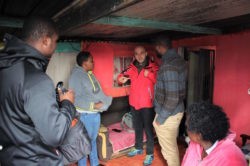A new year... and a new colleague!
2020 has officially begun, and we wish everyone a very happy new year! At SIHMA, we are all back to work and have exciting plans for the coming year. Joining us this year is our brand-new Project Manager, James Chapman. He will be in charge of the many projects currently starting up at SIHMA, including research on a variety of migration-related topics. James used to work as the...

Intern Experience at SIHMA - Angelique
My internship program at the Scalabrini Institute for Human Mobility in Africa (SIHMA) was a fantastic experience. I am a Business Management student and I never imagined that a research internship would be a perfect match for my degree. My experience at SIHMA has taught me that there is cohesion between business and research. During my internship I learned how to conduct research that contributes to the in-depth reporting of migrant issues and refugee...

Press Review December 2019
NATIONAL COVERAGE Home Affairs: Tshwane UNHCR Protesters Can Live Legally in SA ew.co.za December 5, 2019 Protesters who had camped outside the United Nations High Commission for Refugees in Pretoria last month are legally entitled to be in South Africa. The Department of Home Affairs on Thursday said it checked their status and was trying to get them to return to their homes in the country. Full report: https://ewn.co.za/2019/12/05/home-affairs-tshwane-unhcr-protesters-can-live-legally-in-sa-1?fbclid=IwAR1_ha17c66-6gYEzEIozqT87P6wqNBa5Q9Y-7_f_fZFf0i-lB3DMH6qG4Y South Africa fails in duty to offer refuge dailymaverick.co.za...

My Volunteering Experience at SCCT – Giacomo
My name is Giacomo Distefano. I am 26 years old and I come from Bologna, Italy. I am a doctor and I am particularly interested in paediatric neuropsychiatry. In the last few years, tired of hearing the same empty anti-migrant rhetoric, I started to be more and more attracted by the world of migration. For this reason, during the summer of 2018 I joined a volunteering program organised by the Scalabrinian Agency...

Roundtable on Migration, Labour & Policy Options
On Tuesday December 10, the Catholic Parliamentary Liaison Office (CPLO), The Jesuit Institute and the Scalabrini Institute for Human Mobility in Africa (SIHMA) held a seminar discussion on Migration, Labour & Policy Options in Cape Town. It was intended to be a small round table, with around 16 people attending, representing a number of organisations and the parliament. Father Peter-John Pearson, the director of CPLO, gave a welcome and introduction. Following, Marinda...

Bridges Beyond Borders project
One of the main goals of SIHMA is to influence the minds of the public and to change the predispositions of society with regard to migration and human mobility. This vision came to life in the Bridges Beyond Borders (Ponte di Dialoghi) project, a meeting of innovative technology and interactive education. The Fondazione Centro Studi Emigrazione of Rome (CSER), in collaboration with the Scalabrini Communication Office and the logistic support of...


